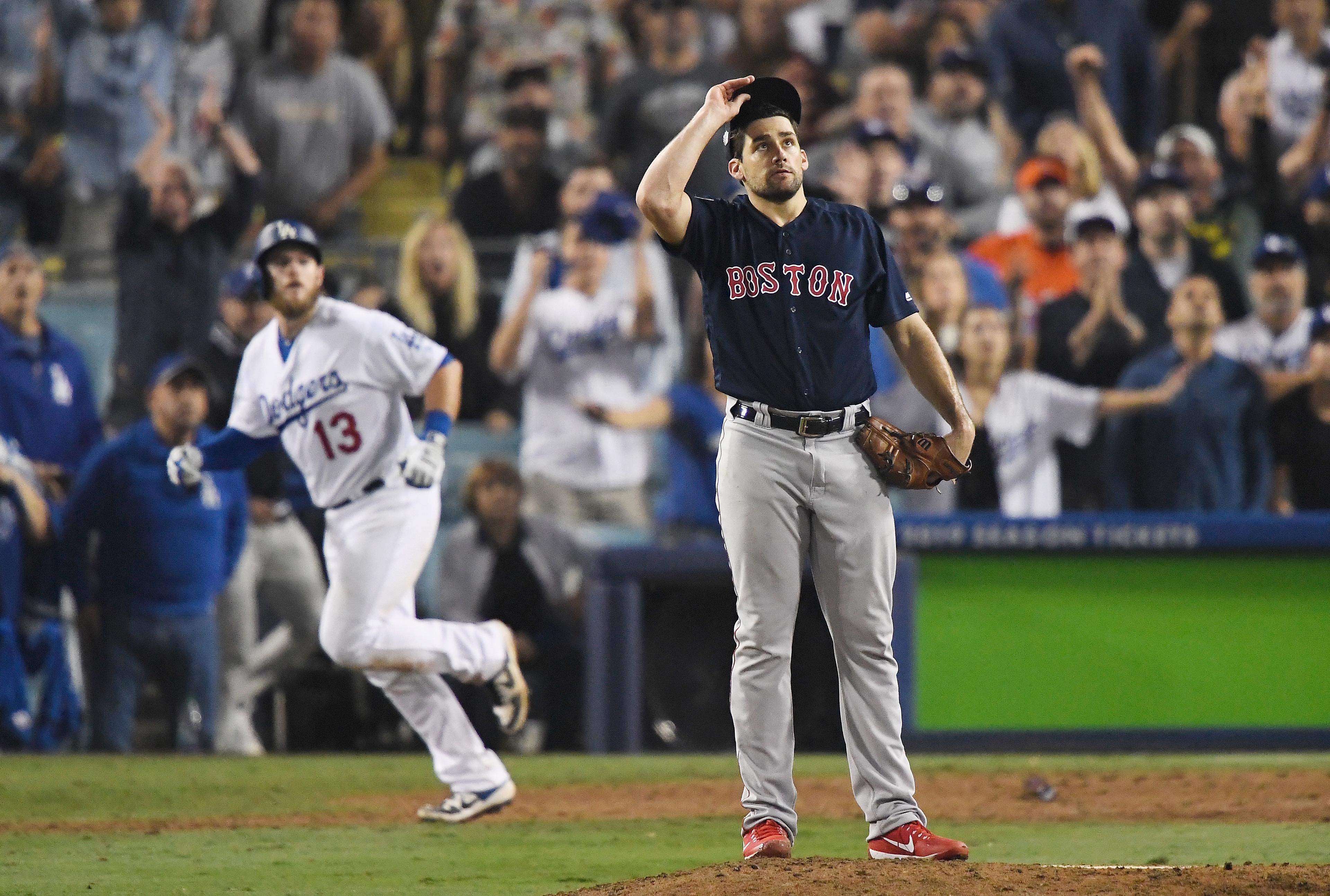
In the bottom of the 15th inning of Game 3 of the World Series, Dodgers first baseman Max Muncy nearly hit a walk-off home run. Muncy’s drive occurred three innings later than Carlton Fisk’s legendary walk-off homer in Game 6 of the 1975 World Series, and perhaps because of the hour, Muncy forgot to wave the ball fair. It hooked foul by just a couple of feet.
Three innings later, Muncy got a second chance, and made the most of it.
This was the kind of game … actually, there’s no kind of game like this. Game 3 was a seven-hour, 20-minute haunted house, totally unique both in its length—by both time and innings this was the longest World Series game by far—and in its strangeness. This was a game in which Muncy could miss a shot at 15th-inning immortality and come back around for another pass through the lineup.
The pitcher who served up both of Muncy’s fly balls—the 15th-inning foul ball and the 18th-inning walk-off homer—was a 28-year-old named Nathan Eovaldi. If baseball’s empirical revolution of the 21st century hadn’t already debunked wins and losses as a measure of pitcher performance, Eovaldi would have. His relief stint of six-plus innings was a superhero’s origin story, and he ended up taking the loss.
After the home run, Eovaldi trudged back toward the visiting dugout—he has broad shoulders and no neck, so his gait has a lot of “trudge” in it to begin with—and his teammates greeted him with encouraging words and pats on the back. The scene took on an eerie, almost spiritual quality as Eovaldi, in his navy uniform top surrounded by teammates in gray hoodies, processed down the dugout steps almost like a fallen hero being carried off the field of battle. Eovaldi did more than could reasonably have been asked of him. He did more than enough to win the game, and his teammates failed him. So the effort of Hercules was turned into the effort of Sisyphus.
During his six-plus innings, Eovaldi threw 97 pitches, a record for a reliever in a World Series game. Of those, 41 were four-seam fastballs, traveling at an average of 98.8 miles per hour and reaching as high as 101.2. He faced 22 batters, as many as Dodgers starter Walker Buehler, whose seven-inning two-hit gem felt like the story of the game when Buehler was lifted what feels like years ago.
Eovaldi entered the game in the 12th inning as the 23rd Red Sox player to see action, tying a World Series record. Likely he expected to see just an inning or two of play, three at the most—no World Series game had ever lasted more than 14 innings before. So Eovaldi came out throwing smoke, hitting triple digits with his fastball early on, and the Red Sox took the lead in the top of the 13th. Eovaldi walked Muncy to lead off the bottom of the inning, then retired the next two batters and arranged for Yasiel Puig to hit a hard ground ball to Red Sox second baseman Ian Kinsler.
Kinsler, a 13-year veteran and former Gold Glover playing in his third World Series, did not have a good game. He entered in the 10th inning as a pinch runner for J.D. Martinez, took three comical shots at getting himself thrown out on the bases, and finally succeeded as he attempted to score on a sacrifice fly. Three innings later, this human banana peel ranged over to his right to corral Puig’s grounder, stumbled, and lurched the ball wide of first base to allow Puig to reach and Muncy to score the tying run.
The play before Kinsler was difficult, but entirely makeable, and he knew it. No matter. Eovaldi chugged on, and “chugged” is the right word, because Eovaldi pitches like he runs on coal and steam—his arms and legs clank through his delivery and produce tremendous power. There’s the aforementioned fastball, offset by a low-90s cutter and a grinding power curveball that behaves like the tourist who’s been duped by a prank Hungarian-English phrasebook in the Monty Python sketch: It goes past the post office 200 yards, then left at the light.
Eovaldi came out of the bullpen after having pitched one inning in each of the first two games of the series, and after having been named Boston’s Game 4 starter. (This was, of course, before Alex Cora discovered that Game 3 would end up lasting an hour longer than the original Star Wars trilogy.) Eovaldi has been Boston’s workhorse this postseason, and appeared six times for 22 1/3 total innings in Boston’s 12 postseason games. He did all this despite joining the team only three months ago, and despite an extensive injury history.
Once upon a time, Eovaldi was a Dodger, an 11th-round pick in 2008 who reached the big leagues at age 21 throwing 100 mph with some idea of where it was going. He is a native of Alvin, Texas, famously the home of another hard-throwing right-hander, Nolan Ryan. But while Ryan struck out more batters than anyone in baseball history, and piled up 200-inning seasons with ease for 20 years, Eovaldi’s triple-digit heater brought him neither durability nor strikeouts.
Early in his big league career, Eovaldi’s fastball was too easy to square up, not that it mattered—he could never stay on the field. He had Tommy John surgery as a high schooler in 2007, and his big league career was just one injury after another—an abdominal strain, back soreness, and shoulder inflammation. He’s qualified for just one ERA title in his career, and bounced from the Dodgers to the Marlins to the Yankees to the Rays and finally to Boston this past July.
In 2016, Eovaldi looked like he’d figured it out, scrapping his changeup and sinker and replacing them with a splitter and a cutter, the latter of which he now throws about a third of the time. But just as he was turning into an effective pitcher, he needed another Tommy John surgery and missed all of 2017. Even though he’s still relatively young, Eovaldi is a journeyman tottering between two outcomes: the breakout season that’ll land him stability and a big payday; and the injury that will finally end his career for good.
So Eovaldi pitched into the early hours of Saturday morning with quite a bit at stake. Succeed and Eovaldi would have all but secured a World Series ring and a big free-agent contract. Fail, and the Dodgers would be right back in the series, and Eovaldi would put more high-stress miles on his weary arm for nothing.
Eovaldi’s two-inning max-effort stint stretched into a third as his teammates booted the ball around like a hot potato covered in bees. Then a fourth, on a twice-reconstructed elbow and a balky back, as his teammates once again failed to score. Then a fifth, and a sixth, and a seventh. Chug. Clank. Chug. Clank. In inning no. 6, his fastball started to fade, and his release point began to waver as the steam engine wore down. And then, when Muncy got his third look at Eovaldi, bang.
Eovaldi gave the standout performance of the postseason in a losing effort. Buehler’s play may have been more virtuosic and Muncy’s late-inning heroics more impactful, but Eovaldi’s was the most memorable. Baseball is a contest of attrition, of not only prowess and cunning, but also mental endurance and willpower. When combined with baseball’s unequaled literary tradition, there’s hardly a more romantic figure in sports than the solitary pitcher, holding back the tide with one arm again and again and again, just trying to buy another inning for his teammates.
The Red Sox demanded more of Eovaldi than he was physically capable of contributing. That the quantity of his effort was so clearly evident, and that it ultimately came to nothing, only makes his performance more poetic. A slap-happy and bleary-eyed nation watched Eovaldi conduct a one-man last stand in the middle of the night, pushing himself up to and over his physical edge. He deserved better than to take the loss, cold comfort though that may be.
